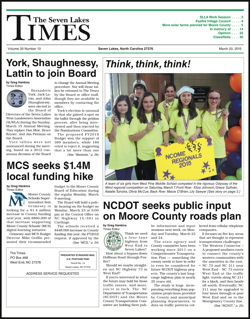 The dues paid by Seven Lakes Landowners Association [SLLA] members haven't kept pace with inflation, and they don't come close to allowing the SLLA to amass the funding needed for capital maintenance projects laid out in the Reserve Study.
The dues paid by Seven Lakes Landowners Association [SLLA] members haven't kept pace with inflation, and they don't come close to allowing the SLLA to amass the funding needed for capital maintenance projects laid out in the Reserve Study.
Those were the takeaways from a presentation on the history of SLLA dues that Treasurer Conrad Meyer made to his fellow Directors during their Monday, July 9 work session.
Noting that "we don't have enough money to do everything we need to do" and "we haven't had a dues increase in a while, Meyer said his presentation was "step one on understanding where we are with dues."
Eighty-three percent of SLLA dues revenues come from homeowners, who currently pay $900 annually, while the $570 fee paid by single undeveloped lots contribute ten percent of the total. Dues paid on the second or third lot owned by a member, at $397, make up the remaining seven percent.
Dues Haven't Kept Up with Inflation
Though homeowners saw their dues increase by $50 in 2009 and another $50 in 2010, all of that additional revenue is deposited in the restricted reserve for road maintenance and state-mandated dam repairs. The $800 portion of dues that fund Association operations has not increased since 2005.
Over the past decade, SLLA homeowner's dues have increased from $750 to $900, an average annual increase of 1.6 percent. Inflation, measured by the Consumer Price Index, was 2.5 percent per year over the same period. Had dues kept pace with inflation, homeowners would be paying $960 annually.
Because the $50 increases in 2009 and 2010 were not applied to undeveloped lots, dues for those landowners have increased at an average annual rate of only 0.9 percent, and have not, in fact, experienced a dollar increase since 2005. Had dues for that category of landowners kept pace with inflation, they would be paying $665, instead of $570.
Similarly dues for the second or third lot -- multiple lot dues -- do not contribute to the restricted reserve for roads and dams and have not increased since 2005. Had dues on those lots kept pace with inflation, they would be paying $444 instead of $397.
Reserve Study Recommended Hefty Increases
The consulting firm that conducted the Reserve Study for the Association recommended a $100 dues increase in 2011, another $100 in 2012, and yet another in 2013, in order to allow the Association to accumulate the reserves needed to pay for the maintenance of its assets: roads, buildings, the pool, etc.
"The purpose of these recommended increases was to fund all the replacement work that needs to be done around here," Meyer said, noting that the recommended increase had not been implemented in either 2011 or 2012.
"We are now behind the eight ball," he said. "We will have to be very selective about the projects that we implement and have to be very vigilant with our reserves."
Both Director Don Fentzlaff and President Bob Darr remarked that the projected cost of repairs in the Reserve Study appear to be fairly high estimates. Meyer added that the study envisions the replacement of dump trucks and lawn mowers which may not, in fact, be replaced.
Although the estimates may be high, Darr said, "the problem is that we are not in the business of generating any funds to take care of those issues that we need to address. That's a more important issue than whatever great deal we may be able to get when we actually bid the particular item."
Next Steps: Fine Tune the Reserve Study
"Where do we go from here?" Meyer asked.
"We reexamine the projects in the Reserve Study -- particularly paving -- and put in what we know today, so we understand what the plan is going to look like. I can't fund a plan that I don't have."
"We need to tweak the reserve study. Once that plan shakes out, we can balance that against some scenarios on a dues increase. But we need to do this sooner rather than later."
"It bothers me if we voted a $100 per lot increase for roads, that we restricted that to homes and did not include vacant lots," Director Bob Racine said. "I think one of the first steps we should do is plug that loophole, so that folks who have lots not built on should be paying their fair share of capital improvements."
"I think you are right on target," Meyer replied, "and I think that is likely to be the conclusion as we go down that path."
President Darr asked Meyer to make his presentation at the July 25 open meeting.
"This dues increase thing needs to be talked about on a continual basis," Darr said, "because it seems to me we are going to be putting before the community a dues increase -- and I think the more information the community gets as we go along the better off the community is going to be. They can vote with more knowledge."
